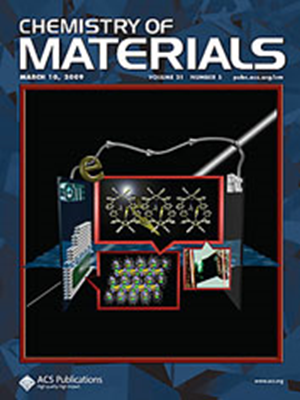氢化和脱氢制备多晶YTiGe金属间化合物
IF 7
2区 材料科学
Q2 CHEMISTRY, PHYSICAL
引用次数: 0
摘要
电子材料是一种新兴的材料,具有独特的结构特征,具有带正电的晶格框架和被捕获在结构腔中的间隙阴离子电子,具有特殊的功能。电子的热力学稳定性和电子稳定性主要取决于阴离子电子的存在及其与晶格框架相互依赖的结构排列。在固定的化学式中,阴离子电子的不同排列可以提供意想不到的性质,但在电子中却很少发现。在这里,我们通过加氢和随后的脱氢过程证明了金属间化合物YTiGe电极在环境压力下的稳定多晶形式。我们发现氢化导致了从P4/nmm结构的YTiGe电极到I4/mmm结构的YTiGeH1.5氢化物的相变。重要的是,实验证实,即使在完全脱氢后,I4/mmm结构仍被保留。我们的理论计算表明,阴离子电子在四面体Y4和八面体Y2Ti4腔中都有定位,这表明P4/nmm和I4/mmm结构的YTiGe化合物是多态电子。这种多晶YTiGe体系表现出明显的磁性,其中I4/mmm结构的YTiGe由于具有较高浓度的准原子阴离子电子而具有较高的磁矩。这些结果强调了探索多晶电子作为功能材料的氢化-脱氢过程。本文章由计算机程序翻译,如有差异,请以英文原文为准。

Polymorphic YTiGe Intermetallic Electride Created by Hydrogenation and Dehydrogenation
Electrides are emerging materials with unique structural features of a positively charged lattice framework and interstitial anionic electrons trapped in structural cavities, exhibiting exceptional functionalities. Thermodynamic and electronic stabilities of the electrides are mainly dominated by the existence of anionic electrons and their structural arrangements that are interdependent with the lattice frameworks. Different arrays of anionic electrons in a fixed chemical formula can provide unexpected properties but are hardly found in electrides. Here, we demonstrate the stable polymorphic forms of intermetallic YTiGe electride at ambient pressure via hydrogenation and subsequent dehydrogenation processes. We find that hydrogenation leads to a phase transition from the P4/nmm structured YTiGe electride to the I4/mmm structured YTiGeH1.5 hydride. Importantly, it was experimentally confirmed that the I4/mmm structure was retained, even after complete dehydrogenation. Our theoretical calculations demonstrate that the anionic electrons are localized in both tetrahedral Y4 and octahedral Y2Ti4 cavities, indicating that P4/nmm and I4/mmm structured YTiGe compounds are polymorphic electrides. This polymorphic YTiGe electride system shows distinct magnetic properties, where a higher magnetic moment is obtained in the I4/mmm structured YTiGe due to a higher concentration of quasi-atomic anionic electrons. These results accentuate hydrogenation–dehydrogenation processes for exploring polymorphic electrides as functional materials.
求助全文
通过发布文献求助,成功后即可免费获取论文全文。
去求助
来源期刊

Chemistry of Materials
工程技术-材料科学:综合
CiteScore
14.10
自引率
5.80%
发文量
929
审稿时长
1.5 months
期刊介绍:
The journal Chemistry of Materials focuses on publishing original research at the intersection of materials science and chemistry. The studies published in the journal involve chemistry as a prominent component and explore topics such as the design, synthesis, characterization, processing, understanding, and application of functional or potentially functional materials. The journal covers various areas of interest, including inorganic and organic solid-state chemistry, nanomaterials, biomaterials, thin films and polymers, and composite/hybrid materials. The journal particularly seeks papers that highlight the creation or development of innovative materials with novel optical, electrical, magnetic, catalytic, or mechanical properties. It is essential that manuscripts on these topics have a primary focus on the chemistry of materials and represent a significant advancement compared to prior research. Before external reviews are sought, submitted manuscripts undergo a review process by a minimum of two editors to ensure their appropriateness for the journal and the presence of sufficient evidence of a significant advance that will be of broad interest to the materials chemistry community.
 求助内容:
求助内容: 应助结果提醒方式:
应助结果提醒方式:


